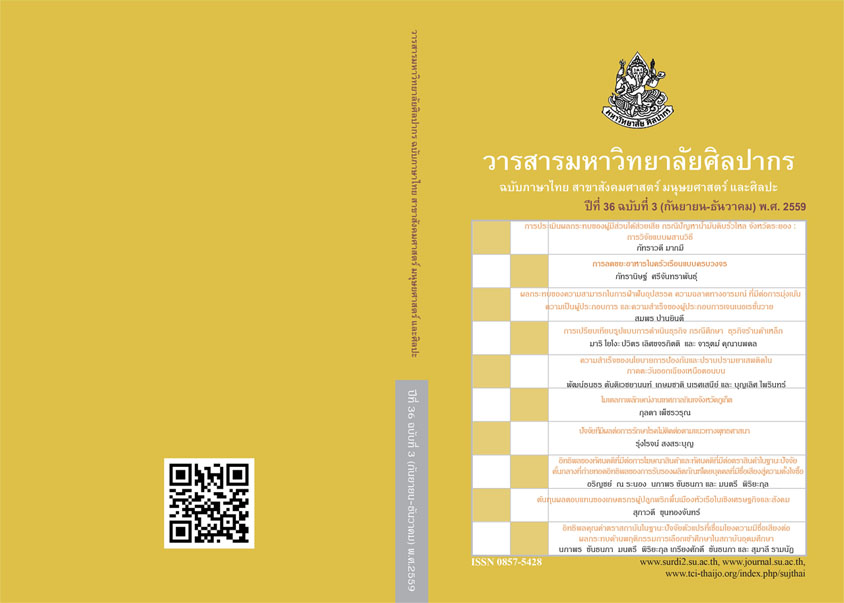อิทธิพลคุณค่าตราสถาบันในฐานะปัจจัยตัวแปรคั่นกลางที่เชื่อมโยงความมีชื่อเสียง ต่อผลกระทบด้านพฤติกรรมการเลือกเข้าศึกษาในสถาบันอุดมศึกษาเอกชน (Influences of Institutional Brand Equity as Mediator Factors in Corporate Reputation to the Impact of Behavioral Intention to Study in Private Higher Education Institutes)
Main Article Content
Abstract
การวิจัยครั้งนี้มีวัตถุประสงค์เพื่อศึกษา อิทธิพลคุณค่าตราสถาบันในฐานะปัจจัยตัวแปรคั่นกลางที่เชื่อมโยงความมีชื่อเสียงต่อผลกระทบด้านพฤติกรรมการเลือกเข้าศึกษาในสถาบันอุดมศึกษาเอกชน เป็นการวิจัยแบบผสมผสาน (mixed method research) ทั้งการวิจัยเชิงปริมาณ (quantitative research) และวิจัยเชิงคุณภาพ (qualitative research) โดยการการวิจัยเชิงปริมาณ เป็นการเก็บข้อมูลด้วยแบบสอบถามกับกลุ่มตัวอย่างจำนวนทั้งสิ้น 790 ชุด วิเคราะห์ด้วยค่าเฉลี่ย ค่าส่วนเบี่ยงเบนมาตรฐานและการวิเคราะห์ตัวแบบสมการโครงสร้างโดยใช้โปรแกรมสำเร็จรูปทางสถิติ PLS Graph 3.0 สำหรับการวิจัยเชิงคุณภาพ ใช้การสัมภาษณ์เชิงลึกด้วยการสัมภาษณ์แบบมีโครงสร้างกับนักศึกษาระดับปริญญาตรี ชั้นปีที่ 1 ของสถาบันอุดมศึกษาเอกชน จำนวน 18 คน
ผลการวิจัยเชิงปริมาณ พบว่า ชื่อเสียงของสถาบันอุดมศึกษาเอกชนมีค่าเฉลี่ยรวมอยู่ในระดับมาก เมื่อพิจารณาองค์ประกอบชื่อเสียงของสถาบันอุดมศึกษาเอกชนเป็นรายด้าน พบว่าทุกด้านมีค่าเฉลี่ยอยู่ในระดับมาก ทั้งนี้ด้านวิสัยทัศน์และภาวะผู้นำ มีค่าเฉลี่ยสูงที่สุด ส่วนตัวแปรคุณค่าตราสถาบันมีค่าเฉลี่ยอยู่ในระดับมาก เมื่อพิจารณาเป็นรายด้าน พบว่า ทุกด้านมีค่าเฉลี่ยอยู่ในระดับมาก โดยด้านความเชื่อมโยงกับตราสินค้ามีค่าเฉลี่ยสูงที่สุด สำหรับความตั้งใจเข้าศึกษามีค่าเฉลี่ยอยู่ในระดับมาก หากพิจารณาแยกเป็นรายข้อ พบว่า มีค่าเฉลี่ยอยู่ในระดับมากทุกประเด็น โดยมีความยินดีจะแนะนำให้บุคคลอื่นเข้าศึกษาในมหาวิทยาลัยแห่งนี้มีค่าเฉลี่ยสูงสุด และด้านพฤติกรรมการเลือกเข้าศึกษาในภาพรวมมีค่าเฉลี่ยอยู่ในระดับมาก เมื่อแยกพิจารณารายข้อ พบว่า มีค่าเฉลี่ยอยู่ในระดับมากทุกประเด็น โดยที่มหาวิทยาลัยมีเงินกองทุนรัฐบาลให้กู้ยืมเพื่อการศึกษามีค่าเฉลี่ยสูงที่สุด
ผลการวิเคราะห์ตัวแบบสมการโครงสร้างพบว่าความตั้งใจเข้าศึกษา (PI) มีอิทธิพลทางตรงต่อพฤติกรรมการเลือกเข้าศึกษามากที่สุด (DE= 0.787) ในขณะที่คุณค่าตราสถาบันมีอิทธิพลทางอ้อมต่อพฤติกรรมการเลือกเข้าศึกษามีค่าเท่ากับ (IE = 0.661) และชื่อเสียงของสถาบันมีอิทธิพลทางอ้อมต่อพฤติกรรมการเลือกเข้าศึกษา มีค่าน้อยที่สุด (IE = 0.139) ซึ่งสอดคล้องกับข้อสมมติฐานที่ระดับนัยสําคัญทางสถิติที่ระดับ 0.01
ผลการวิจัยเชิงคุณภาพเพื่อเป็นการยืนยันคำถามการวิจัย พบว่าข้อสรุปจากการวิจัยเชิงคุณภาพโดยการสัมภาษณ์เชิงลึกมีความสอดคล้องกับการวิจัยเชิงปริมาณ ด้านชื่อเสียงของสถาบัน ด้านคุณค่าตราสถาบัน ด้านความตั้งใจเข้าศึกษาและด้านพฤติกรรมการเลือกเข้าศึกษา นอกจากนี้ยังได้ข้อค้นพบที่เป็นทฤษฎีฐานราก (grounded theory) คือความตั้งใจเข้าศึกษา (purchase intention) ของนักศึกษาได้รับอิทธิพลจากคุณค่าตราสถาบัน (brand equity) โดยการให้บริการที่มีคุณภาพ (services quality) เป็นปัจจัยที่เข้ามาเปลี่ยนความสัมพันธ์ระหว่างคุณค่าตราสถาบันกับความตั้งใจเข้าศึกษา
Downloads
Article Details
References
Aaker, D. A. (1991). Managing brand Equity: capitalizing on the value of a brand name. New York: Free Press.
Aaker, D. A. (1996). Building Strong Brands. New York: The Free Press.Aaker, D. A. and Joachimsthaler, E. (2000). Brand Leadership. New York: The Free Press. [Online]. Retrieved April 10, 2015 from http://search.proquest.com/docview/227013838?accountid=44787
Barwise, P. (1993). Brand Equity: snark or boojum?. International Journal of Research in Marketing, 10(1): 93.
Best, J. W. (1981). Research in Education (4th ed). Englewood Cliffs, NJ: Prentice-Hall.
Boulding, W., Kalra, A., Staelin, R., and Zeithaml, V. (1993). A dynamic process model of service quality: form expectations to behavioral intentions, Journal of Marketing Research, 30: 7-27.
Buil, I., Martínez, E., and de Chernatony, L. (2013). The Influence of Brand Equity on Consume Responses.The Journal of Consumer Marketing, 30(1): 62-74. [Online]. Retrieved f April 20, 2015 from doi:http://dx.doi.org/10.1108/07363761311290849
Chang, H. H. and Chen, S. W. (2008). The Impact of Customer Interface Quality, Satisfaction and Switching Costs on E–Loyalty: internet experience as a moderator. Computers in Human Behavior, 24(6), 2927-2944.
Chin,W. W.(2001). PLS Graph User’s Guide Version 3.0. [Online]. Retrieved March 15, 2013, from http://www.pubinfo.vcu.edu/carma/Docume
Chin,W. W. (1998). Commentary: Issues and opinion on structural equation modeling. MIS Quarterly, 22(1), p. 12.
Creswell, J. (2008). Educational Research: Planning, Conducting, and Evaluating Quantitative and Qualitative Research. Upper Saddle River, NJ: Pearson Merrill Prentice Hall.
Cronbach, L. J. (1974). Essentials of psychology testing. New York: Harper and Row
Dennard, E. A. (2000). The influence of Psychosocial Factors on College Choice and Subsequent Student Satisfaction with College Experiences. Texas, United States.
Einwiller, S. A., Carroll, C. E., and Korn, K. (2010). Under What Conditions do the News Media Influence Corporate Reputation? The Roles of Media Dependency and Need for orientation. Corporate Reputation Review, 12(4): 299.
Fombrun, C. J., Gardberg, N. A., and Sever, J. M. (2000). The Reputation Quotient SM: A Multi-Stakeholder Measure of Corporate Reputation. The Journal of Brand management, 7(4): 241-255.
Jonsen, K., and Jehn, K. A. (2009). Using triangulation to validate themes in qualitative studies. Qualitative Research in Organizations and Management, 4(2), 123-150. DOI: http://dx.doi.org/10.1108/17465640910978391
Keller, K. L. (1993). Conceptualizing, Measuring, and Managing Customer-Based Brand Equity. The Journal of Marketing, 57(1): 1-22.
Keller, K. L. (1998). Strategic Brand Management: Building, Measuring, and Managing Brand Equity. Upper Saddle River, NJ: Prentice Hall.
Moven, J. C. and Minor, M. (1998). Consumer Behavior. Upper Saddle River. NJ: Prentice-Hall.
Nunnally, J. C. (1978). Psychometric Theory. (2nd ed.). New York: McGraw-Hill
Puncheva-Michelotti, P. and Michelotti, M. (2010). The Role of the Stakeholder Perspective in Measuring Corporate Reputation. Marketing Intelligence & Planning, 28(3): 249-274. [Online]. Retrieved March 15, 2013. DOI: http://dx.doi.org/10.1108/ 02634501011041417.
Schivinski, B. and Dabrowski, D. (2013). The Impact of Brand Communication on Brand Equity Dimensions and Brand Purchase Intention through Face Book. GUT FME Working Paper Series A. Gdansk (Poland): Gdansk University of Technology. Faculty of Management and Economics, 4: 1-24.
Temple, P. (2006). Branding Higher Education: Illusion or Reality?Perspective: Policy &Practice in Higher Education, 10: 15-19.
Van Riel, C. B. M. and Berens, G. (2004). Corporate Associations is The Academic Literature: Three Main Streams of Thought in The Reputation Measurement Literature. Corporate Reputation Review, 7(2): 161-178. [Online]. Retrieved March 15, 2014, from http://www.ebsco.com.


